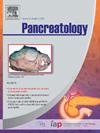胰腺导管内乳头状黏液恶性肿瘤加胰液细胞学诊断的最佳适应症。
IF 2.8
2区 医学
Q2 GASTROENTEROLOGY & HEPATOLOGY
引用次数: 0
摘要
背景/目的:胰腺液细胞学(PJC)阳性是考虑导管内乳头状粘液瘤(IPMN)患者手术切除时的重要发现;然而,指南不推荐内窥镜逆行胆管造影(ERCP)治疗PJC。本研究旨在阐明在IPMN患者中添加PJC诊断高级别发育不良(HGD)和浸润性癌(IC)的价值。方法:选取广岛大学医院行术前PJC及手术切除的IPMN患者,回顾性分析基于PJC、临床及影像学表现对恶性IPMN的诊断率及ercp后胰腺炎(PEP)的发生率。结果:在129例符合条件的患者中,61例(47%)为恶性肿瘤(HGD 29例,IC 32例)。PJC的敏感性、特异性、阳性预测值和阴性预测值分别为33%、97%、91%、62%和67%。多因素分析显示,胰管口径突变是PJC真阳性的独立预测因素(风险比:15.81,P = 0.001),这些患者的PJC诊断敏感性为86%。结论:IPMN患者虽然一般不推荐PJC,但对于胰管口径突变伴远端胰腺萎缩的患者,确定治疗策略是值得考虑的。本文章由计算机程序翻译,如有差异,请以英文原文为准。
Optimal indication of adding pancreatic juice cytology in the diagnosis of malignant intraductal papillary mucinous neoplasm of the pancreas
Background/Objectives
Positive pancreatic juice cytology (PJC) is an important finding when considering surgical resection in patients with intraductal papillary mucinous neoplasm (IPMN); however, guidelines do not recommend endoscopic retrograde cholangiopancreatography (ERCP) for PJC. This study aimed to clarify the findings worthy of adding PJC for diagnosing high-grade dysplasia (HGD) and invasive carcinoma (IC) in patients with IPMN.
Methods
Patients with IPMN who underwent preoperative PJC and surgical resection at Hiroshima University Hospital were enrolled, and the diagnostic yield of malignant IPMN based on PJC and clinical and imaging findings and the incidence of post-ERCP pancreatitis (PEP) were retrospectively analyzed.
Results
Of the 129 eligible patients, 61 (47%) had malignant tumors (29 HGD and 32 IC). The diagnostic yields of PJC were as follows: 33%, 97%, 91%, 62%, and 67% for sensitivity, specificity, and positive predictive value, and negative predictive value, respectively. Multivariate analysis revealed that an abrupt change in the pancreatic duct caliber was an independent predictive factor of true-positive PJC (hazard ratio: 15.81, P = 0.001), with a diagnostic sensitivity of 86% for PJC in these patients. The incidence rate of PEP was 19%, and the pancreatic body and tail lesions, main pancreatic duct diameter <10 mm, and placement of a nasopancreatic drainage catheter were significant risk factors for PEP.
Conclusions
Although PJC is generally not recommended for patients with IPMN, it is worth considering for the determination of treatment strategies in patients with abrupt changes in the caliber of the pancreatic duct with distal pancreatic atrophy.
求助全文
通过发布文献求助,成功后即可免费获取论文全文。
去求助
来源期刊

Pancreatology
医学-胃肠肝病学
CiteScore
7.20
自引率
5.60%
发文量
194
审稿时长
44 days
期刊介绍:
Pancreatology is the official journal of the International Association of Pancreatology (IAP), the European Pancreatic Club (EPC) and several national societies and study groups around the world. Dedicated to the understanding and treatment of exocrine as well as endocrine pancreatic disease, this multidisciplinary periodical publishes original basic, translational and clinical pancreatic research from a range of fields including gastroenterology, oncology, surgery, pharmacology, cellular and molecular biology as well as endocrinology, immunology and epidemiology. Readers can expect to gain new insights into pancreatic physiology and into the pathogenesis, diagnosis, therapeutic approaches and prognosis of pancreatic diseases. The journal features original articles, case reports, consensus guidelines and topical, cutting edge reviews, thus representing a source of valuable, novel information for clinical and basic researchers alike.
 求助内容:
求助内容: 应助结果提醒方式:
应助结果提醒方式:


